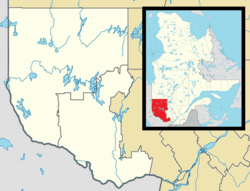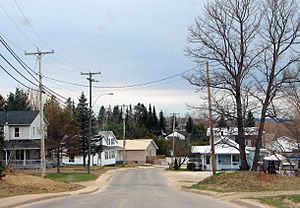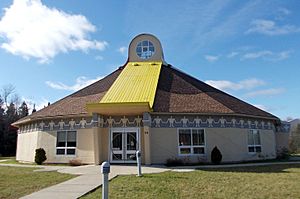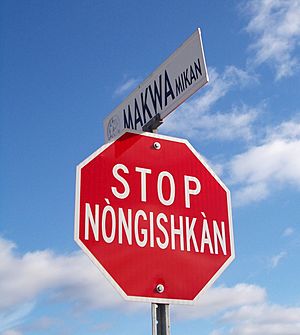Kitigan Zibi facts for kids
Quick facts for kids
Kitigan Zibi
|
|
|---|---|
|
First Nations Reserve
|
|
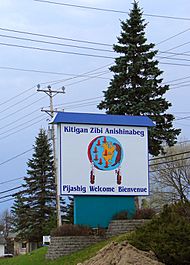
Welcome sign
|
|
| Country | |
| Province | |
| Region | Outaouais |
| Established | 1851 |
| Government | |
| • Type | Band council |
| Area | |
| • Total | 210.09 km2 (81.12 sq mi) |
| • Land | 195.06 km2 (75.31 sq mi) |
| Population
(2021)
|
|
| • Total | 1,204 |
| • Density | 6.2/km2 (16/sq mi) |
| Time zone | UTC−05:00 (EST) |
| • Summer (DST) | UTC−04:00 (EDT) |
| Postal Code |
J9E
|
| Area code(s) | 819 |
Kitigan Zibi is a special place called a First Nations reserve. It is home to the Kitigan Zibi Anishinabeg First Nation, who are an Algonquin community. This reserve is located in Quebec, Canada, where the Désert and Gatineau Rivers meet. It is also right next to the town of Maniwaki.
With an area of about 210 square kilometers, Kitigan Zibi is the largest Algonquin Nation in Canada. This is true for both its size and the number of people living there. On the reserve, you will find many important places. These include schools, shops, a health center, a youth center, and even their own radio station, CKWE 103.9.
Contents
What Does Kitigan Zibi Mean?
The name Kitigàn comes from the Algonquin language. It can be translated to "garden," "cultivated land," or "cleared land." This name might have come from a clearing made by the Hudson's Bay Company. They built a trading post and a garden there a long time ago.
Nature and Geography
Kitigan Zibi is surrounded by beautiful rivers. The Eagle River is on its west side, the Désert River on the north, and the Gatineau River on the east. Most of the community is built along or near Highway 105. However, much of the reserve is still covered by forests.
The reserve also has many lakes. There are 13 large freshwater lakes and about 29 smaller lakes and streams. These waters are home to many types of fish. You can find walleye, pike, bass, trout, carp, catfish, and even freshwater sturgeon here.
Wildlife in Kitigan Zibi
The forests and lands of Kitigan Zibi are full of amazing animals. You might see beavers, muskrats, fishers, martens, and minks. Other animals include otters, bobcats, lynx, cougars, deer, black bears, wolves, and moose.
A Look at History
The history of Kitigan Zibi is closely connected to the nearby town of Maniwaki. Both communities grew at the same time.
In the early 1800s, Algonquin people from the Lake of Two Mountains area came to the Désert River region. Their leader was Chief Pakinawatik. Soon after, in 1832, the Hudson's Bay Company set up a trading post there. This post was at the mouth of the Désert River.
Later, in the 1840s, a group called the Missionary Oblates of Mary Immaculate started a mission. They asked the government to set aside land for the Algonquins. Chief Pakinawatik and other leaders traveled by canoe to Toronto three times. They worked hard to get the reserve land set aside.
The boundaries for the land were drawn in 1850. The Oblates named this area Maniwaki. But in the Algonquin language, it was known as Kitigànsìpì or Kitigàn Zìbì, meaning "Garden River."
The Reserve's Official Start
The reserve was officially created in 1851 and marked out in 1853. At first, it was called "Manawaki" or "River Desert." But on September 24, 1994, the community officially changed the name to "Kitigan Zibi."
In the late 1990s, some parts of the town of Maniwaki were added to Kitigan Zibi. This happened because of land claim settlements. In 2019, the Canadian government agreed to pay the Kitigan Zibi community $116 million. This settled 29 claims for land that was taken between 1873 and 1917 for the town of Maniwaki. The community also filed a claim in 2016 for land in Ottawa. They believe they still own the land where the Parliament of Canada stands.
Community and People
As of May 2022, the Kitigan Zibi Anishinabeg First Nation has 3,685 members. About 1,624 of these members live on the Kitigan Zibi reserve. The other 2,061 members live off the reserve.
Language Spoken
According to the 2016 census, people living on the Kitigan Zibi reserve speak different languages at home:
- English: 62.7%
- French: 15.2%
- Algonquin: 18.0%
- French and English: 1.2%
Economy and Work
The community of Kitigan Zibi has its own forestry company called Mitog. This company has an agreement to cut trees on their traditional lands. They also work with other logging companies. They are important partners in managing the Eagle Forest, an area west of Maniwaki. Here, logging, outdoor activities, and protecting wildlife all happen together.
The community also has a large maple grove. It has 12,000 taps for making maple syrup. This area has even more potential to grow. Kitigan Zibi is where the delicious Awazibi pure maple syrup is made.
Education
There is one school located on the Kitigan Zibi reserve:
- Kitigan Zibi Kikinamadinan School


